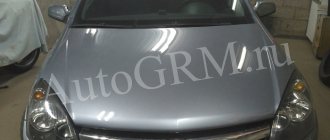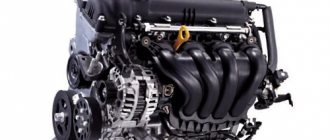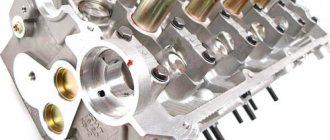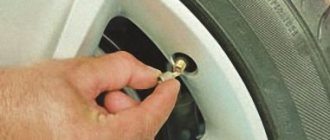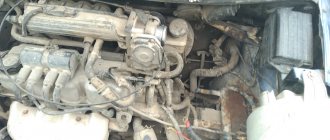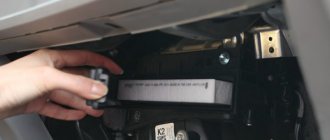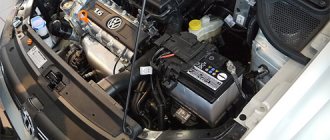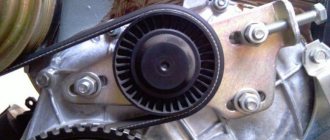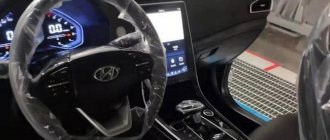Kia and Hyundai service
Why you should visit us:
Car service "Auto-Mig".
We do absolutely everything in terms of repairing Kia and Hyundai cars.
Our employees have vast experience and a large number of satisfied customers; all work complies with the manufacturer’s recommendations. In view of this, by trusting us, it is as if you are giving repairs to the manufacturer. Our service provides high-quality services for repairing your car, offering the most reasonable prices in terms of price/quality ratio, so those who contact us never return with the problem they came with, choosing “Auto-Mig” constantly from now on. We strive to provide the best possible safety in repairing everything we undertake.
By servicing with us, you are already allowing your vehicle to last much longer without breakdowns.
"Auto-Mig" is a guarantee of reliability and stability of your car in any conditions.
It is worth noting that modern Korean cars are not old copies of the Japanese, these are first-class cars of various classes, and are repaired in a special way, they already have their own history and can be repaired efficiently using only professionally thought-out technologies.
Our auto repair center provides the following services:
- full diagnostics of the internal combustion engine, gearbox and electronics;
- diagnosing individual nodes, directions;
- repairs of any complexity;
- air conditioner maintenance (troubleshooting, refilling);
- identification of unknown breakdowns due to which other service stations refuse and subsequent elimination.
We have the most advanced equipment that helps to repair your vehicle better than anyone else, increasing the level of work done to the maximum.
We work on all Kia and Hyundai models, please contact any of our technical centers for details.
Kia repair at AutoMig Auto Service Center
(examples of completed work):
Hyundai repair at Auto-Mig Auto Service Center
(examples of completed work):
Repair of commercial vehicles in our technical center:
Many Korean cars are used by companies - these are small Porter and Bongo trucks. And for passenger transportation, usually Starex H-1 and Carnival. For these fleets, we also offer our friendly approach and maximum attention.
- We work on a cashless basis
- We conclude contracts
- We provide all the necessary documents for accounting
Commercial vehicle servicing
(examples of completed work):
Checking the car before purchasing
- We will help you buy a car without any pitfalls. Checking the car before purchasing will ensure that it meets the technical conditions declared by the seller.
And just a little more about our technical center:
Our specialists will perform engine and suspension repairs of almost any degree of complexity. We use official electronic catalogs and strictly follow repair technology. When carrying out repair work, we use spare parts only from well-known manufacturers, which we purchase directly from importers, which ensures their low cost.
At the AutoMig car service center you can repair the brake system of your Kia or Hyundai using high-quality materials and according to the manufacturer’s technology.
Come, we will be happy to help you!
Even experienced specialists involved in car sales cannot always answer such a question as what would be better for a Hyundai Solaris car: a chain or a timing belt. In fact, the lack of knowledge on this issue confuses ordinary buyers a little. Fortunately, you can figure everything out on your own. First, it’s worth understanding what kind of drive
the Hyundai
Solaris is equipped with: belt or chain. There's nothing complicated about it. If there is a chain, it will be inside. The belt is located outside.
Difference between drives
What is better on Solaris - a chain or a belt? This question plays an important role for almost every car enthusiast. Moreover, some even rely on this fact when it comes to choosing a vehicle. The difference lies in the following points:
- Unlike a belt drive, the chain on the Hyundai Solaris is protected from a variety of external factors.
- A chain drive works almost four times more than a belt drive. Among other things, the belt stretches over time.
- When the oil pressure in the system decreases, the hydraulic tensioner cannot operate at its maximum capacity.
- The belt is much quieter and more elastic. It does not require lubricating fluid. Replacing it can be done without completely disassembling the power unit.
Modern cars are equipped with different gas distribution drives. Which to choose? The driver makes this decision independently. In recent years, not only on Hyundai, but also on other cars, belts have become more reliable, and therefore chains are gradually fading into the background.
What timing drive is on the Hyundai Solaris: chain, photo and video
Car: Hyundai Solaris. Asks: Kirill Smirnov. The essence of the question: What type of timing drive is installed on the Hyundai Solaris?
Good afternoon, I want to buy myself a Hyundai Solaris. Tell me what drive is installed there. I want there to be a chain, but I can’t find out the exact answer! And tell me, is it better or worse than the timing belt?
Timing drive for Hyundai Solaris CHAIN
What do we see? Chain! Engine 1.6 in the photo.
Even qualified specialists at a car dealership cannot answer the question of what kind of drive is installed on the Hyundai Solaris, namely a timing chain or a timing belt, constantly getting confused in their versions. And this all looks quite strange, since you can recognize this even with the naked eye: if the belt is not visible from the outside, then it is a chain drive.
Engines for Hyundai Solaris
1.4 liter engine (G4FA) 1.6 liter engine (G4FC) The timing chain of the G4FC/ engine is visible
Hyundai Solaris cars were equipped with two types of engines, 1.4 liters (G4FA) and 1.6 liters (G4FC) and both of them have a chain drive gas distribution mechanism.
Which is better, a chain or a belt?
Since the choice of drive in a car is sometimes decisive in the choice of the entire vehicle, you should learn in detail about the advantages of chain drive.
As you can see, the chain is in excellent condition.
Advantages of chain drive
- The timing chain of the Hyundai Solaris is completely protected from the influence of any external factors, such as weather, humidity, dirt, and so on.
- The service life of a chain is almost four times longer compared to a belt. The facts of its rupture are practically excluded, and only minor sprains are possible.
- The chain endures local engine overloads more resistant than the belt.
- In a circuit, phase shifters are much more reliable, stronger and structurally simplified.
Benefits of belt drive
- Since the belt is much more elastic, it is able to dampen vibrations much more effectively.
- The belt operates more quietly and does not require lubrication, which cannot be said about the chain.
- To replace the belt, you do not need to disassemble the motor.
Choosing a car with a timing belt or chain is the right of every owner. Judging by the fact that the quality of timing belts today is constantly improving, you can choose a car with such a drive to save money. However, if you have the means to own a car with just such a drive, you should not deny yourself, since a broken timing belt is not a rare occurrence, and a broken timing chain is rather an exception to the rule.
Timing chain drive price for Hyundai Solaris and articles
The price for a new timing chain varies from 8,000 to 10,000 rubles and has its own catalog number - 243212B200.
Remember that, just as in the case of a timing belt, if the chain breaks, a major overhaul of the engine will be required, so it is better to protect yourself in advance and buy a car with a chain drive.
Video about checking the chain on Hyundai Solaris
korean-car.ru
Source: autoprivat.ru
Broken chain drive: consequences
The timing chain on a Hyundai Solaris rarely breaks, but it is impossible to completely eliminate this kind of problem. If a break occurs while the engine is running, the consequences will be dire. The valve bushings will fail, the valves themselves will be bent, and damage will affect most elements of the cylinder-piston group. In other words, you will have to do a major overhaul of the engine.
Replacing the timing belt will not cause problems. You will have to allocate only an hour of free time for her. As for replacing the timing chain, this procedure is quite complicated. It is done this way:
- Dismantle the battery.
- Remove the cylinder head, as well as the engine protection.
- Move the piston in the first cylinder to the upper extreme position.
- Pour the oil out of the engine.
- Place the support under the pallet, then unscrew the nuts of the right support bracket. Next, remove the nut of the stud holding the right motor mount. Remove the bracket.
- Move the hydraulic power steering pump.
- Remove the tensioner bracket holding the right engine support.
- Remove the belt roller.
- Drain the antifreeze.
- Dismantle the cooling system pump pulley, and therefore the pump.
- Unscrew the crankshaft pulley bolt, and then move the pulley to the side.
- Disconnect all wires from the generator.
- Remove the generator and timing cover.
- Remove the tensioners and then the chain.
That's all! There should be no problems with assembly; it is done in the reverse order.
Many car owners are familiar with such a malfunction as a broken chain or timing belt. But not everyone knows how to pull it back. Some even have a special tensioner in their car, but have no idea how to use it if the need suddenly arises. So, how is the Hyundai Solaris timing chain replaced?
Do valves bend on a Hyundai Solaris?
Many car enthusiasts are interested in whether the valves on the Hyundai Solaris 1.6 and/or 1.4 are bent. It is impossible to answer this question unambiguously. The listed problems associated with the engine accompany the car throughout its operation. In addition to this, the engine on the Solaris is “disposable”, and if the valve is bent and/or the piston is jammed in the cylinder head, then restoration will require replacing the entire block, since there is no boring for the repair size.
Tips for replacing the timing chain on a Hyundai Solaris
As previously reported, the process of replacing a timing belt is complex and multi-step. The main stages of replacing the timing belt will be:
- Remove the engine splash guard;
- Set the piston of the first cylinder to the TDC position;
- Remove the upper bracket of the right power unit support;
- Remove the accessory drive belt;
- Remove the water pump;
- Remove the generator;
- In addition, unscrew the bolts and remove the timing cover;
- Dismantle the two tensioners;
- Remove the chain by turning the camshaft clockwise;
- Install the timing chain in reverse order, aligning the necessary marks;
- Apply sealant to the timing cover and install it. Tighten the bolts “10” with a torque of 9.8 - 11.8 Nm, and the bolts “12” with an applied force of 18.6-2.5 Nm.
Spare parts needed for replacement
Timing chain : original Hyundai/Kia drive chain 243212B000. Cost 2400 rubles. And also available replacement chains from different brands with a lower price tag: Amd AMDCS22, CGA 02CHA603RA, Dominant HY2403514A020, the estimated price will be 1300 rubles.
Offer for timing chain tensioners : original timing chain tensioners from manufacturers: Hyundai/Kia art. 2441025001; Chrysler product code 2441025000. The price of the originals will be 2000 rubles. You can also purchase goods at a cheaper price from Nsp, product code NSP022441025001 for 1,750 rubles.
You will also need: pump gasket - 251242B000, front oil seal - 214212B030, shoe No. 1 - 244202B000, shoe No. 2 - 244312B000.
Source: etlib.ru
When is replacement necessary?
Tensioning a new chain is not too difficult, and in case of a breakdown somewhere far from home, any car enthusiast can independently restore the functionality of the Hyundai Solaris. Just don’t forget that the chain breaks once and for all, so in addition to the tensioner, you definitely need a new chain.
However, to prevent such a problem from happening and the timing belt does not have to be changed, you should monitor the condition of the chain. When the chain is stretched, it begins to dangle and this can be seen when examining this unit. This is when replacement is required. It is better to do this in advance than in emergency conditions. Moreover, replacement is quite easy.
It is important to understand that if the chain is still holding, then replacing it is also possible in car repair shops, where professionals with experience in such work will undertake this. However, you need to remember how much money it will cost to replace just one part.
On a Hyundai Solaris car, the camshafts are driven by a chain. It is more reliable than timing belts, which break and require frequent attention and maintenance.
Myths and reality
1. The engines are made in China, and therefore the quality is not very good.
The engines are indeed manufactured in China, but what is more important is that the production of the engines is established at the Hyundai Motor Co. plant, and therefore the quality is guaranteed by a well-known Korean manufacturer. Note that even some premium cars, such as Volvo models, are assembled in China, including their flagship S90.
2. The engine cylinder block is aluminum, disposable and non-repairable.
In fact, the design of the cylinder block allows the liners to be replaced with new thin-walled cast iron ones, so the engine can be repaired several times using the relining method. Moreover, the price of such repairs is often comparable to the cost of restoring an engine with a cast iron block, provided that the pistons are left the same (and in some cases this is possible).
It will be useful Lubrication functions for battery terminals and an overview of products, protecting terminals from oxidation
3. The crankshaft has a design with only four counterweights, and therefore bends more than, for example, VAZ “transverse” engines.
Yes, from the point of view of engine design, the Korean shaft experiences heavy loads, but the practice of repairing such high-mileage engines shows that wear on the main and connecting rod journals is usually minimal, and the matter is limited to installing new nominal bearings.
4. Engine life is 180,000 km, after which the engine can be thrown out.
Practice shows that with good care, some engines can last 400,000 kilometers or more. I only recommend changing the engine oil more often - once every 7,500 - 10,000 km, filling up with fuel at branded gas stations and preventing the engine from overheating.
5. Lightweight and shortened pistons quickly begin to hang out in the cylinders.
Yes, of course, the design of the pistons is not the same as that of the “millionaires” of the eighties and nineties of the last century, but relatively inexpensive repairs with the replacement of pistons and rings, as well as troubleshooting and repair of the cylinder head at a mileage of 200,000 km can significantly extend the life of the engine.
6. The timing chain drive is not particularly reliable.
Up to a mileage of 150,000–200,000 km, the chain usually runs without any major complaints with good oil and a calm driving style. A multi-row toothed chain serves very well and sometimes the sprockets wear out more than the chain.
7. The lack of hydraulic compensators creates a lot of problems for the owner.
According to the maintenance regulations, valve adjustments should be carried out at least every 90,000 km. The real need for adjustment usually occurs somewhat later than the specified period. Another thing is engines running on gas. Here the gaps really need to be monitored more carefully. In general, saving on hydraulic compensators is really a minus of this engine. And, what’s most offensive, the ancestor, the G4EC engine of the first generation Hyundai Accent, had hydraulic compensators.
8. Phase shifters have an unreliable design.
In fact, complaints about phase shifters are sporadic, and only when the oil is not changed on time or its quality is low.
9. Noisy engine operation, especially noticeable at idle.
Yes, there is a characteristic “chirping” of the fuel injectors, which is not particularly pleasant to the ear, but this is the only loud sound produced by a working engine.
10. Destruction of the ceramic block of the catalytic converter disables the piston group of the motor.
The ceramic block of any catalytic converter is really not particularly durable under our operating conditions. If the neutralizer is placed far enough from the engine, then there is no danger to the latter. This arrangement is used by some automakers (for example, Renault), but not Hyundai. When chipped, pieces of neutralizer ceramics can actually get into the cylinders and damage the working surfaces. Destruction is promoted by:
- Accumulation of unburnt fuel in the ceramic block due to misfires.
- Mechanical damage to a section of the exhaust system and sudden thermal shocks when overcoming puddles.
- Use of low-quality fuel and large amounts of fuel additives.
Step-by-step instruction
Replacement intervals for Hyundai Solaris are not regulated by the manufacturer.
The main malfunction of the chain is its stretching, which leads to a shift in valve timing and noise. Eliminated by replacing with a new one. Replacement work is quite labor-intensive. It is necessary to carefully make a diagnosis; a diagnostician who has an oscilloscope in his arsenal can help you with this; he will take an oscillogram from your engine and compare it with the reference one. It will show exactly the valve timing angles. After this, he will give you recommendations for replacing the timing chain.
24410-25001 article no. Chain tensioner.
Required tools and accessories:
- Oil container
- Set of heads
- Set of open-end wrenches
- Rags
- Hammer
- Screwdrivers
- Passatizhi
- Jack
Open the hood and remove the negative terminal from the battery. We unscrew the protection and drain the oil from the engine.
Drain the antifreeze from the cooling system into a container.
Unscrew the Hyundai Solaris valve cover and remove it.
We support the Hyundai Solaris engine under a jack through a plank. We unscrew the engine mount bracket from the timing side and dismantle it.
Remove the generator drive belt by using a key to release the tensioner.
It is necessary to move the power steering pump to the side by unscrewing the pump mounts.
Unscrew the belt tensioner (bolt with reverse thread). We remove it from the block.
Using a socket wrench, unscrew the 4 bolts of the right engine mount bracket and remove it.
Using a wrench, unscrew the support roller bolt and remove it.
The liquid pump pulley is held on by four bolts; to keep it from turning, you need to unscrew them and remove the pulley.
Unscrew the bolts securing the water pump to the engine block (5 pieces). Remove it by prying it off with a slotted screwdriver.
Using a socket wrench, unscrew the belt pulley bolt (if you have a manual transmission, ask your partner to engage fifth gear and press the brake pedal; if you have an automatic transmission, use a special holding tool).
We remove the pulley from the end of the crankshaft by prying it with a mounting tool from different sides.
It is necessary to dismantle the generator by first disconnecting the block, pressing the latch, then using an open-end wrench we unscrew the power wires from the contact bolt of the Hyundai Solaris engine generator.
Unscrew the upper and lower bolts securing the generator to the bracket and remove the generator.
Remove the bracket from the motor by unscrewing the two bolts.
The timing cover is held on the block by fourteen bolts, which must be unscrewed, after which we remove the timing cover.
It is necessary to set the top dead center of the piston of the first cylinder, guided by the marks on the shafts.
Fix the shoe tensioner with a pin, pressing the shoe with a screwdriver. Unscrew the two tensioner bolts and remove it.
We remove the timing chain from the camshafts and the crankshaft sprocket. We take it out of the engine compartment.
We inspect for damage and wear on the teeth of the camshaft sprocket and crankshaft.
We clean all adjacent surfaces on the cover and block. We clean the surface of the tensioner and its seat on the block.
We install the timing chain on the sprockets, aligning them according to the marks (on the new chain, for convenience, the marks are marked with paint).
We install the tensioner by applying sealant to the back.
The gas distribution mechanism (or timing) is responsible for supplying fuel or air to the combustion cylinders, as well as for removing exhaust gases. The timing mechanism of the Hyundai Solaris consists of:
- camshaft;
- chains;
- levers;
- intake and exhaust valves;
- channels.
The camshaft operates from the crankshaft, to which it is connected via a chain. Many other cars have a belt. Let's look at the pros and cons of these two parts.
Timing belt
And despite the fact that many are still looking for a timing belt in Solaris, it is not in this car. The belt is installed on earlier versions of Hyundai passenger cars, for example, on the Hyundai Getz with the Alpha engine type.
One of the advantages of the belt is the absence of noise during operation. The belt itself and its replacement are relatively inexpensive compared to a chain. And it doesn't need to be lubricated.
But there are many more disadvantages. Firstly, the short period of work. You will definitely have to change it 2 times a year to avoid ruptures. Secondly, changing the belt yourself is much more difficult, so it is recommended to contact services where the prices are not always encouraging with their figures. And this is the main disadvantage. The average price for replacing a timing belt is 15,000 rubles.
Valve train chain
The Hyundai Solaris is equipped with two types of engines, which differ only in volume: 1.4l and 1.6l. These engines are from the Gamma series, which use a Solaris timing chain instead of a belt.
Unlike a belt, a chain is strong and reliable. It does not need to be changed; in some older car models, its maintenance only includes lubrication. But during operation you can hear extraneous sounds, which is a minus. If it stretches or breaks, it can scratch other elements of the mechanism in flight. This is not even taking into account the fact that replacing the chain itself is not a cheap pleasure.
However, the manufacturers took these nuances into account and “hid” the chain in the block, and instead of one tensioner, they made two. When the chain is stretched, this allows it to be held in place, preventing injury to other parts of the mechanism. Also, the chain does not require maintenance and can easily operate up to 250-300,000 km. Many car enthusiasts continue to debate what is better: a belt or a chain.
Many people are ready to change the belt, rollers, pump and antifreeze every six months, but at the same time enjoy silence during the trip. Others prefer not to bother with the car, even if the chain is a little audible. However, we don’t choose a car based on its timing mechanism, so whether it’s a belt or a chain, just enjoy a pleasant and comfortable ride with the Hyundai Solaris!
Lucky. On 1.4 and 1.6 gasoline engines, a chain gas distribution mechanism is installed. On the one hand, this means greater reliability (cases of a circuit break are quite rare). On the other hand, it saves car owners from frequent replacement of the timing belt.
In our Moscow network, we carry out all types of work on diagnostics, repair and replacement of timing belt elements
Solaris Hyundai timing belt or timing chain: decoding
When choosing a Korean Hyundai Solaris, car owners are interested in: “What is installed on the gas distribution mechanism – a belt or a chain?” Even at dealerships, sales managers cannot always give a clear answer. This material will help clarify this and other pressing issues.
Engine models for Hyundai Solaris
Engine 1.4 liter Gamma series. Engine 1.6 liter Gamma series.
Now we can say with confidence that under the hood of this model there are mainly Gamma class gasoline engines:
- G4FA – 1.4 l (107 hp);
- G4FC – 1.6 l (123 hp).
The device of these two types is approximately the same. There are no special design differences observed. The only difference is the piston stroke length and the different crankshaft.
What do we see? Chain! Engine 1.6 in the photo.
In the timing mechanism (serves for timely supply of the fuel mixture to the cylinders and exhaust gases), in addition to the camshaft, levers and valves, a chain drive is installed.
According to Hyundai officials, the element does not need tightening. This function is performed by a hydraulic tensioner under oil pressure.
Distinctive features of the chain
- Reliability and no need for replacement (compared to a belt) every 60 thousand kilometers.
- Overload resistance.
- Complete dismantling is carried out after approximately 210 thousand km or as a result of broken links (extremely rare).
- Among the disadvantages, as with other car brands, it is easy to highlight increased operating noise.
Advantages of a belt over a chain
Proponents of belt drives claim that the engine is quieter and the efficiency is much better. Thanks to the elastic properties of the material, vibrations and vibrations are more effectively damped. Modern developments make it possible to avoid costly repairs when a part breaks.
The main thing is to do maintenance on time and buy only original spare parts.
So here, as they say, it’s a matter of taste.
Design features of the chain engine on Solaris
As practice has shown, the power unit copes well with the loads placed on it. With timely maintenance, no early breakdowns were identified (according to the service book up to 180 thousand km).
Engines of the Gamma type, which replaced the Alpha model range in 2010, are equipped with an aluminum block and do not have hydraulic compensators.
A characteristic disadvantage is increased oil consumption. The valves are adjusted after 100 thousand kilometers or when there is a sharp increase in noise under the valve cover.
From the technical characteristics, sufficient power stands out (for 1.6 l) - 123 l. With. and 6000 rpm, as well as the presence of 16 valves. The DOHC gas distribution system is quite reliable. There is no chance of the chain slipping under critical tension. The displacement of the cylinder axis relative to the crankshaft helped reduce the load on the piston skirts.
The convenient location of the intake and exhaust manifolds also deserves attention. When servicing a nearby injector, convenient access is ensured.
How to determine the country of manufacture of the engine
This engine is made in China. Basically, these were the models that were imported into the Russian Federation.
The company's factories are located not only in Korea, but also in different parts of the world. There is a strict technical quality control system everywhere. It doesn't matter whether it's China or the USA. To accurately determine the place of production, just look at the VIN code marking. The last letter in the row indicates the country of assembly:
- Korea (A – Asan; H – Hwasung; P – Poseung; S – Sohari; U – Ulsan).
- Türkiye (T – Izmit).
- USA (K – Montgomery).
- China (B – Beijing; W – Shandong).
- India (M – Chennai).
- Slovakia (Z – Zilina).
conclusions
Instead of a conclusion, it is worth noting that each car has its own positive features and annoying shortcomings. The example of this model shows that the Korean auto industry is worthy competition for famous brands and is still popular on Russian roads. Take care of your car and good luck on your journey!
korean-car.ru
Periodicity
The manufacturer does not regulate the time for replacing the chain on Solaris. This means that the car can be driven until it is overhauled or breaks down. The reliability of the chain is quite high. We have already accumulated a wealth of experience in servicing Korean brand cars that have traveled 200-300 thousand kilometers.
But the absence of the need to replace the Hyundai Solaris timing chain does not negate the complex of works associated with checking the functionality of the entire gas distribution mechanism, tensioner, tension pins and auxiliary rollers.
First of all, you need to ensure that the chain is properly tensioned. And if it subsides, tighten it. Another problematic spare part is the hydraulic chain tensioner. If it fails, a break may occur, so it is necessary to check it regularly and, if necessary, replace it.
Timing chain or belt - which is better for Hyundai Solaris
As you know, the balanced operation of the gas distribution mechanism directly affects the performance of the engine. Accordingly, all its elements, in particular the belt, must always be in working condition. In this article you will find out which is better for the Hyundai Solaris timing chain: a chain or a belt and you can watch a video of replacing components.
Hyundai Solaris cars are equipped with two types of engines: G4FA and G4FC. The volume of the first is 1.4 liters, the second - 1.6 liters. They are designed the same, do not have any design differences and belong to the “Gamma” class.
Engine Hyundai Solaris
Unlike other types of engines, on the Gamma the gas distribution mechanism is equipped with a chain rather than a belt. For Solaris owners, this is a significant advantage, since the drive belt must be replaced every 60 thousand kilometers. Replacing the chain, in turn, is not regulated by the Solaris manufacturer. As a rule, it changes in the event of a major engine overhaul or in the event of a break.
In practice, failure of the chain is detected no earlier than after 250-300 thousand kilometers.
Step-by-step instruction
This replacement process requires certain knowledge and experience. If you are faced with the need to change a chain for the first time, then it is better not to do it yourself, but to have your car repaired at a service station. For those car owners who want to replace the element on their own, we suggest using this material.
Loading …
What to cook?
You will need:
- key heads;
- spanners;
- flat and Phillips screwdrivers;
- pliers.
Set of socket wrenches Wrenches Flat and Phillips screwdrivers Pliers
Instructions
- First, disconnect the battery and remove the cylinder head cover. You will also need to dismantle the internal combustion engine protection, and then set the piston of the first cylinder to the TDC position.
- Drain the engine fluid from the internal combustion engine.
- Place a reliable support under the motor, then unscrew the screws that secure the right support of the unit. Then you need to unscrew the corresponding screws to remove the right motor mount mount.
- Using a key, you should turn the tensioner roller to loosen the belt. Then remove the accessory drive belt from the shafts.
- After this, it is necessary to dismantle the fastening screw of the power steering pump, move the device to the side and unscrew the fastening screw of the tensioner. This is done by turning the pin clockwise as it has a reverse thread. Remove the tension device.
- Next, you should unscrew the fastening screws of the lower bracket of the right support and remove it. After this, remove the screw securing the belt roller and remove the roller itself.
- Then you need to drain all the antifreeze that is in the system. The draining procedure may take more than 20 minutes. Next, holding the antifreeze pump pulley, remove the four screws securing it. Remove the pump shaft, and then unscrew and remove the screws securing it to the motor cylinder head. The pump along with the rubber seal can be removed.
- Unscrew the screw securing the crank pulley and remove the pulley itself. Then you need to disconnect the block with wires from the generator. Unscrew the nut, and then remove the generator itself.
- Now you should unscrew all the screws of the timing device. Remove the cover, and then remove the tension pins and the tensioner of the mechanism chain itself. Turn the timing pulley clockwise.
- After this, the chain itself can be removed. Install the chain following the reverse order of work. When installing, make sure that the installation bolt on the crank pulley is located at the top. All contacting elements of the tensioner must be cleaned of old sealant residues. These components should then be coated with new sealant.
- Install the timing chain tensioner. Make sure that the marks on the camshaft gears and on the chain match. Carry out all further steps in reverse order. You can find out more about changing the component in the video.
1. Turn the tensioner roller 2. Remove the drive belt from the shaft 3. Remove the drive belt 4. Remove the tensioner 5. Remove the timing chain protective cover 6. Remove the timing chain
Video “Do-it-yourself timing chain replacement”
You can watch a video of replacing the timing chain using the example of a Hyundai Getz car; the procedure is generally similar to the Hyundai Solaris model.
AvtoZam.com
